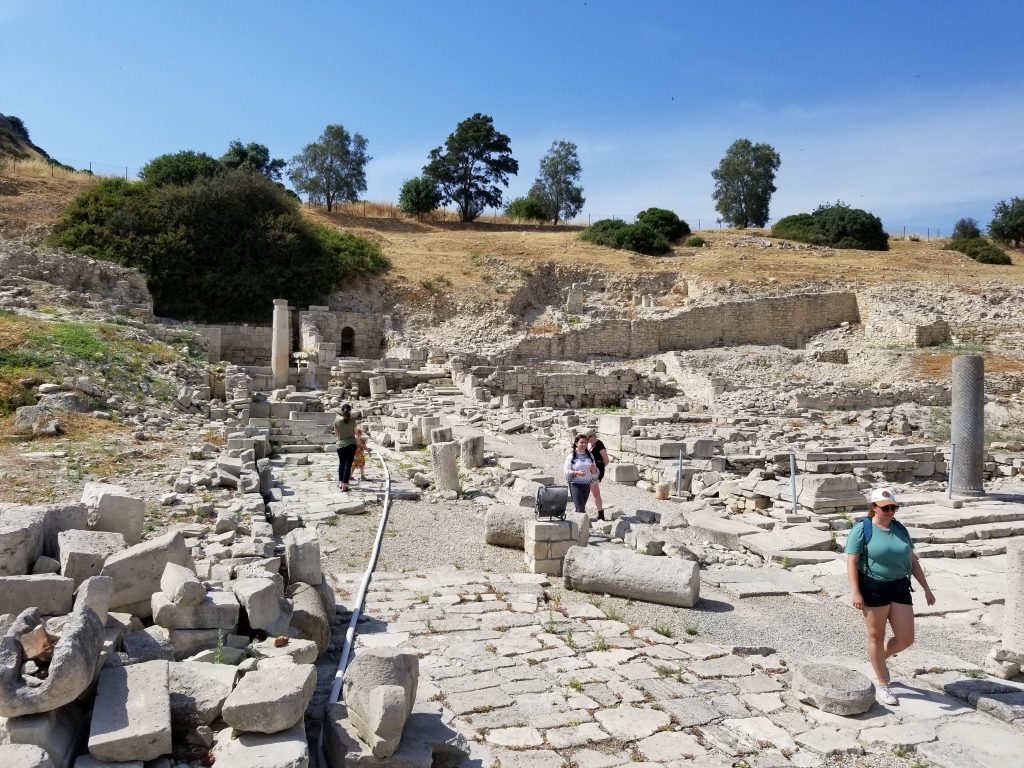Now that we’ve all left Larnaca and are strangely nostalgic about the past four weeks, we thought we’d reminisce about living in Larnaca. This will be our last post for this summer, but we’ll add occasional posts about the project during the year, so check back for updates. Information about next year’s fieldschool will be posted here in the winter. If you’re interested in participating or have any questions about the project, you can always contact Professor Tom Landvatter.
Continue reading “Living in Larnaca”Author: Beth Platte
Wrapping up
The end of an archaeological field season is a hectic time. In addition to trying to either finish trench excavation or leave the trench in a safe state for additional excavation next season, there is pottery to wash, finds to process, photos to take, and archaeological drawings to do.

Pottery and Paphos
Thursday and Monday were shooting days, so we spent Thursday exploring the many archaeological sites in the region of Paphos and Monday washing pottery.

Deciphering our μοῖραι
Yesim and Hayley
Many things are available along Larnaca’s turquoise seafront: martinis, phallic slingshots, and sketchy tattoos out the back of large white vans. But most notable, perhaps, is the small green corner shop offering udon noodles, ponzu sauce, and Greek fortune cookies. The best part of a meal from Wok in the Box, besides price, is always the small slips of paper that crumble from the insides of the cookies — equipped with glib sayings nearly as illegible in English as in Greek. Since we’re still waiting with bated breath to discover any inscriptions in the field pottery, we’re keeping our skills sharp by valiantly attempting translations. A Herculean task, since Ancient Greek never had much to say about computer science. Homeric couplets about toilet paper may not be very impressive, but we hope Ellen will be proud of us for practicing (with flash cards!) nonetheless… at least enough to avoid proskynesis.

[our commentary will be in brackets]
Continue reading “Deciphering our μοῖραι”Everyone gets a wall

It’s only Wednesday, but it’s been an eventful week. We’ve opened a small new trench adjacent to the south trench, and we’re nearly ready to close that unit, the south trench, and the north trench. In the middle trench, we’re tantalizingly close to reaching the ancient floor level in what we think is a room.
Continue reading “Everyone gets a wall”It’s getting hot in here
It’s hot this week. And archaeology is hot work. We’re halfway through the field season, and we’ve made some significant progress in all three of our trenches. Each trench highlights a different type of archaeological problem which we are addressing, and consequently requires different excavation strategies.

Museums and Mosaics
Monday and Tuesday of this week were work days, and we’ve made some exciting progress in the trenches. An update on the archaeological work will come later this week. In addition to work in the field, however, the field school includes several required and optional trips to archaeological sites on Cyprus.
Continue reading “Museums and Mosaics”Progress
Full work days of the 2019 season started on Thursday. This year, we’re digging three trenches. Staff laid out trenches earlier in the week, identifying areas they expect to reveal different aspects of the site. We use GPS devices to mark the perimeters of the trenches, and points will be taken throughout the season to precisely locate finds and features in the trenches and assist in analyzing the site. Continue reading “Progress”
A slow start
One of the interesting aspects of working on the site of Vigla is that it is on a live military firing range. Indiana Jones may be comfortable doing archaeology under fire, but most field schools, ours included, opt for a safer route. This means no work on site on mornings when training exercises are happening–including the first three days of this dig season. Continue reading “A slow start”

